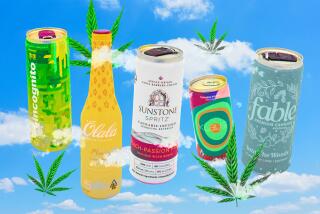Marketing the Mystique of Glacier Ice : Alaska: The state’s prize-winning brewery and distillery both base their beverages on water from glaciers.
- Share via
ANCHORAGE, Alaska — Alaska’s only distillery and its only brewery are both prize winners--and one of the reasons may be the water, which is melted glacier ice.
In a recent “blind” tasting of vodkas conducted by the Memphis Commercial Appeal newspaper, Attakiska vodka, which is made here, placed first. In a feature story on vodka last summer in Town & Country magazine, Attakiska was named “the one American vodka in a class with the imports.”
Alaskan brand beer, brewed in Juneau, the state’s tiny capital, was selected the best beer in America in a poll of 4,500 people attending the annual Great American Beer Festival in Denver in 1988. The beer also won high honors in 1987 and 1989 at the festival--the nation’s largest such event--where 160 domestic beers are judged.
Not a bad record for Alaska’s only two producers of alcoholic beverages, especially considering that the brewery only began production in December, 1986, and the vodka distillery in November, 1988.
Alaska Mountain Top Spirits Co., which operates the first licensed distillery in the history of Alaska, produces Attakiska vodka. Its president is Mark Wilson, 41, who holds a zoology degree from Washington State University. Wilson also heads Wetco, a 7-year-old company that produces, among other things, glacier water and glacier ice. Both firms are based in Anchorage.
In the summer of 1987, Wilson displayed golf-ball-size pieces of glacier ice in Tokyo at an exhibition of Alaskan products. “It was kind of a wacky idea: glacier ice to cool drinks,” Wilson recalled in a recent interview. “The Japanese loved it. It totally caught us off guard.”
Overnight, Wilson found himself in the glacier ice business. His crews began harvesting floating ice in Alaskan bays, chopping it and packaging it in 50-pound bags for export to Japan. He has sold half a million pounds of the ice each year for the past three years, charging about $1 a pound. Now Wetco has eight competitors selling the slow-melting hard ice, which makes a distinctive crackling noise as it chills a drink.
The water used in Attakiska vodka, which retails here for $16.95 a bottle, comes from the melting ice of Eklutna Glacier just outside Anchorage.
“Our plan is to eventually sell about 5% of the vodka in Alaska, with the rest of the sales in the U.S. and Japan,” Wilson said. Last year, one-third of the sales were in Alaska. Most of the rest went east of the Mississippi, and a small amount was sold to Japan.
California is scheduled to receive its first shipment of the vodka this month in San Francisco, he said.
In Juneau, more than 500 miles southeast of Anchorage, Marcy and Geoff Larson, both 32 and married five years, are general partners in Alaskan Brewing & Bottling, makers of Alaskan brand beer. Marcy Larson runs the business end of the brewery; her husband is brew-master. She is a photojournalism graduate of Furman University in Greenville, S.C., and Geoff received a degree in chemistry from the University of Maryland.
Before moving to Alaska to open the brewery, both worked briefly in a small brewery in Iowa and spent three years visiting breweries and reading everything they could find on beer. “We searched the state archives here in Juneau, learning the history of beer making in Alaska,” Marcy Larson said.
In the course of this research, the couple discovered a recipe used by Douglas City Brewing Co., a brewery that operated from 1899 to 1907 in a small town across Gastineau Channel from Juneau.
“We took the . . . recipe, modified it and brew our beer with only natural ingredients: malt, hops, yeast and water--the water from local glaciers,” Geoff Larson said.
Until recently, they called the beer Chinook Alaskan, but now it is simply Alaskan, and a six-pack sells for $7 to $8.
Production grew last year to 125,000 gallons, almost all of it sold in 700 Alaskan stores, bars and restaurants. But the brewery does ship 200 cases a month to Japan.
Whether the early success of Alaska’s two beverage makers really derives from some unique qualities of glacier ice is anyone’s guess, but the Larsons insist that it’s a key ingredient. For consumers, however, the drinks’ mystique may count for as much as their taste.
More to Read
Sign up for The Wild
We’ll help you find the best places to hike, bike and run, as well as the perfect silent spots for meditation and yoga.
You may occasionally receive promotional content from the Los Angeles Times.






